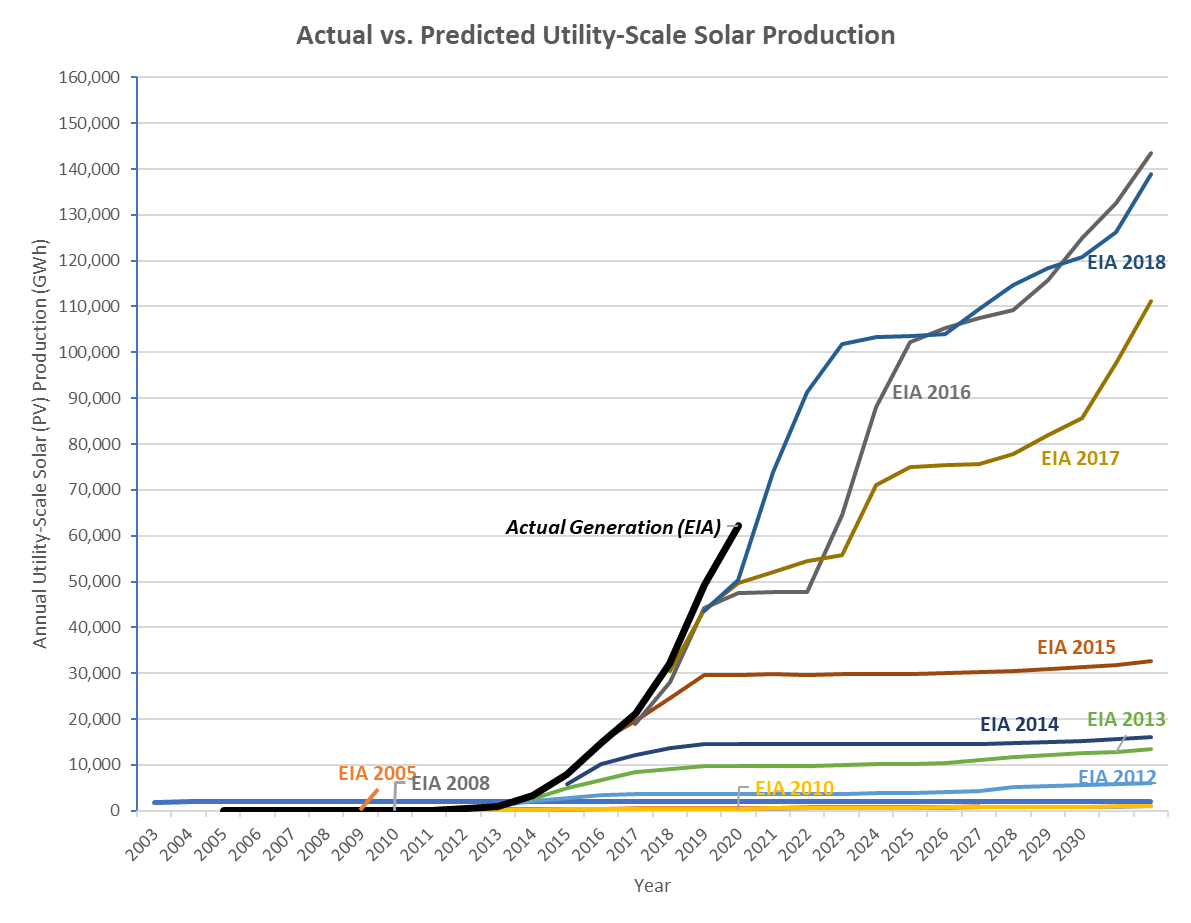Jon Sundby
Policy Associate
The U.S. Energy Information Administration (EIA) – the nation’s energy data and analysis agency – predicted a dim future for solar photovoltaic electricity. They were wrong.
Policy Associate
Getting our economy off fossil fuels in time to prevent the worst impacts of global warming is going to require big changes. Changes that can sometimes be hard to imagine.
Two decades ago, the idea that we could power a significant share of our society with renewable energy was just such a hard-to-imagine change. While visionaries going back to the 1970s and earlier dared to dream of a society running on clean energy, the conventional wisdom was that such a future was far away.
As Frontier Group and Environment America Research & Policy Center’s newest clean energy report documents, change can come rapidly. Renewable energy and electric vehicles have experienced tremendous growth within the past decade. During that time, wind energy more than tripled and over a million electric vehicles were sold.
But of all the clean energy technologies we reviewed in our report, one stands out for its dramatic growth: solar energy.
Solar electricity has been around since the 1950s, when scientists at Bell Labs produced the first silicon photovoltaic (PV) cell. During the subsequent decades, scientists, policy experts and environmental advocates had big dreams for the technology that they believed could revolutionize the way America was powered. But while there were niches where solar thrived, until recently the vision of an emissions-free, solar-powered future seemed as distant as the sun itself.
As recently as 2005, the U.S. Energy Information Administration (EIA) – the nation’s energy data and analysis agency – predicted a dim future for power from solar photovoltaic electricity, projecting that the United States would produce 653 GWh of utility-scale solar electricity in 2018 – the equivalent of powering a little over 62,000 homes.[1] To put that in perspective, that’s not quite enough to provide electricity to the homes of Eugene, Oregon.

Projections from the EIA’s Annual Energy Outlooks compared to actual generation of utility-scale solar energy.
The nation surpassed that mark in 2011, seven years early. The next year, in 2012, the EIA projected that utility-scale solar production would rise to about 3,600 GWh in 2018 – more than five times as much as had been forecast in 2005, and nearly enough to provide electricity for the residents of San Francisco.
In reality, the US produced 62,290 GWh of utility-scale solar electricity in 2018, 17 times the amount predicted in 2012 and nearly enough electricity to power the entire states of Massachusetts and Maine.
Year after year, solar generation has broken past the expectations of the experts. In the past decade, production of solar electricity has grown over 40-fold, turning what was once considered by many a fantasy into reality. This growth is due in part to the technological advances, but it is largely thanks to smart policy on the local, state and federal level. Policies that aim to adequately compensate solar panel owners for the electricity they put onto the grid (net-metering) or which put a price on solar electricity’s environmental and health benefits (subsidies) can help to make sure that the true value of solar energy is realized.
Despite years of doubts and fierce opposition, solar energy has become a major source of electricity in America and is poised to lead us into the 21st century. Already, utility-scale solar is often cheaper than conventional forms of electricity, and new contracts continue to break records for size and cost.
By 2050, Bloomberg New Energy Finance predicts that wind and solar energy will provide nearly half the world’s power. The EIA, in its 2019 outlook, now predicts that by 2050 the U.S. will be producing nearly 544,000 GWh of solar PV electricity – more than enough to power California’s current electricity needs twice over.
That is a lot, but it’s not nearly enough. Whether the task is taking advantage of the awesome potential of solar energy and other forms of renewable power, or making other dramatic changes needed to decarbonize our economy, we are going to need to advance clean technologies and ways of living faster than might currently seem possible. The rapid, unexpected growth in solar energy over the last two decades is an illustration that, with commitment and the right policies, the seemingly impossible can become possible. And quickly.
[1] Using the 2017 EIA estimate that an average residential utility customer used 10,399 KWh annually. U.S Energy Information Agency, How much electricity does an American home use? 26 October 2018, accessed at https://www.eia.gov/tools/faqs/faq.php?id=97&t=3.
Photo: Solar installation at Nellis Air Force base in Nevada, U.S. Air Force (CC-BY-1.0)
Policy Associate
